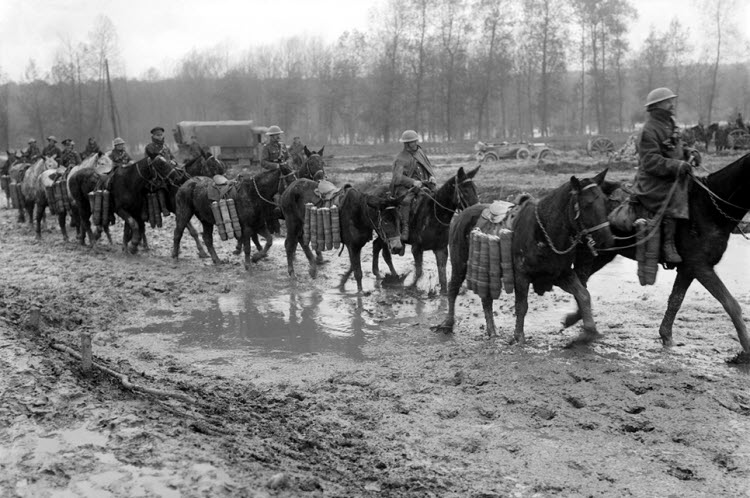
George William Talbot was born in Ossett in 1889 the eldest child of thirteen children born to Charles Talbot and his wife Jane (nee Canavan) who married in the December quarter of 1887 in the Dewsbury area. Tragically, seven of those children died before April 1911.
In 1891, Netherton born coal miner, Charles Talbot and his wife and two young sons, including George William, were living on South Parade in South Ossett. By 1901, the Talbots had left Ossett and were living in Ashington, Northumberland now with three children, including 12 year-old George William. In 1911, the family had returned to Wakefield and were living at 28, West Street, Wakefield.
George William Talbot’s army service record has not survived, but it is known that he enlisted at Ossett and joined the 1st/4th Battalion, King’s Own Yorkshire Light Infantry, with regimental service number 2347. George was a volunteer and embarked for France on the 13th April 1915. He was killed in action on the 7th September 1916 and posthumously awarded the 1914/15 Star and the British and Victory medals.
The 1/4th Battalion, Kings Own Yorkshire Light Infantry was a unit of the Territorial Force with HQ in Wakefield, serving with 3rd West Riding Brigade, West Riding Division. When war broke out in August 1914, the units of the Division had just departed for their annual summer camp at Whitby, and they were at once recalled to their home base and mobilised immediately for war service, moving to Doncaster. In November they moved to Gainsborough and in February 1915 to York to prepare for service overseas, those men who had not volunteered for Imperial Service transferred to the newly formed 2/4th Battalion.
They proceeded to France, from Folkestone landing at Boulogne on the 12th of April 1915 and the Division concentrated in the area around Estaires. On the 15th of May the formation was renamed 148th Brigade, 49th (West Riding) Division. Their first action was in the The Battle of Aubers Ridge in May 1915. In 1916 They were in action in the Battles of the Somme. In 1917 they were involved in the Operations on the Flanders Coast and the The Battle of Poelcapelle during the Third Battle of Ypres. In 1918 they were in action during the Battles of the Lys, The pursuit to the Selle and the Final Advance in Picardy. At the Armistice, The 49th Division was resting at Douai, demobilisation began in early 1919.
On the 4th September 1916, 1/4th KOYLI moved from Aveluy Wood to North Bluff in support of the 1/4th York and Lancaster Regiment. On the 7th September, working parties were clearing communication trenches in the Thiepval sector when they were subjected to a heavy shelling barrage including some gas shells. It was in this shelling that Private George William Talbot was killed, along with Private T. Carter (30) who hailed from Lofthouse Gate, Wakefield. Lt. Col. Haslegrave, the 1/4th KOYLI Commanding Officer was also gassed slightly.1
George William Talbot is not remembered on any Ossett Memorial or Roll of honour, perhaps because he and his family had left Ossett by 1901, albeit returning to Wakefield by 1911. In addition to be being born in Ossett. George also enlisted here. He is remembered in this 2014 biography and Roll of Honour because the Commonwealth War Graves Commission and/or the U.K. Soldiers who Died in the Great War 1914-1918 listing records him as born or residing in Ossett.

Above: Aveluy Wood, Somme, France in September 1916.
Private George William Talbot died on the 7th September 1916 and is buried at grave reference VII. C. 3. at the Lonsdale Cemetery, Athuille,2 Somme, France. Authuille is a village 5 kilometres north of the town of Albert on the D151 road to Grandcourt. The Cemetery (signposted in the centre of Authille) is 1 kilometre east of the village. Access to the cemetery, 500 metres from the road, is by a grass pathway (unsuitable for cars).
On 1 July 1916, the first day of the Battle of the Somme, the 32nd Division, which included the 1st Dorsets and the 11th (Lonsdale) Battalion of the Border Regt attacked the German line at this point and stormed the Leipzig Salient, but were compelled to retire later in the day. In the spring of 1917, after the German withdrawal to the Hindenburg Line, V Corps cleared these battlefields and made a number of new cemeteries, including Lonsdale No.1 and No.2.
Lonsdale Cemetery No.1 (the present Lonsdale Cemetery) contained originally 96 graves (now in Plot I), the great majority of which were those of officers and men of the 1st Dorsets and the 11th Borders. It was enlarged after the Armistice when graves, almost all of 1916, were brought in from the surrounding battlefields and from other small burial grounds, including:-
Lonsdale Cemetery No.2, which was about 500 metres further East. It contained the graves of 38 soldiers from the United Kingdom (31 of whom belonged to the 11th Borders) and two German soldiers.
Nab Road Cemetery, Ovillers-la-Boisselle, which was on the road running up Nab Valley, about 900 metres East of Lonsdale Cemetery. It contained the graves of 27 soldiers from the United Kingdom, who fell in July, September and October 1916.
Paisley Avenue and Paisley Hillside Cemeteries, which were on the South side of Thiepval Wood. They contained the graves of 284 soldiers and Marines from the United Kingdom (mainly of the 49th (West Riding) Division), who fell in July 1916 – February 1917, and two German soldiers.
Lonsdale Cemetery now contains 1,542 Commonwealth burials and commemorations of the First World War. 816 of the burials are unidentified but there are special memorials to 22 casualties known or believed to be buried among them.
References:
1. 1st/4th KOYLI War Diary